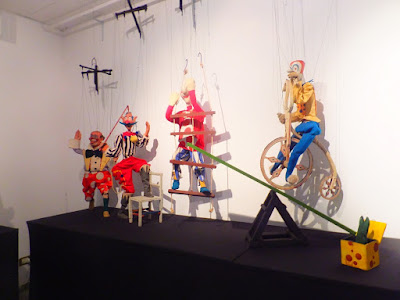 |
| Marionettes are ready to take the stage at the Museo internazionale delle marionette Antonio Pasqualino in Palermo. |
Pinocchio and his fellow puppets are an important part of the Italian culture that I am happy to explore during my stay in Sicily. Palermo is home to the Antonio Pasqualino International Puppet Museum.
 |
| Each puppet at the Museo internazionale delle marionette Antonio Pasqualino in Palermo has distinct features. |
 |
| Knights in armor figure are prominent at Palermo's Museo internazionale delle marionette Antonio Pasqualino. |
The museum was founded in 1975 by Antonio Pasqualino, a surgeon, anthropologist, and expert on Sicilian history and popular traditions, who died in 1995. Along with other members of the Association for the Conservation of Popular Traditions, Pasqualino dedicated much of his life to saving, collecting, and honoring puppets from Sicily and around the world.
 |
| An exhibit at the Museo internazionale delle marionette Antonio Pasqualino in Palermo features puppets made from ordinary household objects. |
 |
| Performances of marionettes from Vietnam take place over water. These are on display at Palermo's Museo internazionale delle marionette Antonio Pasqualino. |
 |
| A display of circus-act puppets are on display at the Museo internazionale delle marionette Antonio Pasqualino in Palermo. |
For a doll collector like me, a visit to this museum is a real treat. As you can see by this small sampling of the many photos I have taken here, I am enchanted by the thousands of marionettes on display.
 |
| Puppets grace the stage at the Museo internazionale delle marionette Antonio Pasqualino in Palermo. |
 |
| A large princess puppet is on display at Palermo's Museo internazionale delle marionette Antonio Pasqualino. |
 |
| Multi-cultural puppets hang around at Palermo's Museo internazionale delle marionette Antonio Pasqualino. |
The museum offers daily puppet shows if there are enough reservations, but we visited another theater in Palermo to see the marionettes in action.
 |
| Audiences can peruse the puppets before the show at Teatro dei Pupi famiglia Argento in Palermo. |
On a narrow alleyway across from the Palermo Cathedral, we find Teatro dei Pupi famiglia Argento, housed in Palazzo Asmundo. Run by the same family since 1893, the puppets and sets were all made by members of this Palermitan puppet master family.
 |
| The show at Palermo's Teatro dei Pupi famiglia Argento features daring knights and a few decapitations. |
The theater was founded by Vincenzo "Cece" Argento and his four sons, who ran a traveling puppet show throughout Palermo and Agrigento provinces. The last of his sons, Giuseppe Argento, who had learned the art marionette-making and performing at age 10, acquired the family business in 1948. His son, Vincenzo, took over in 1993 and it is he who meets us at the door when we arrive at Opera dei Pupi.
 |
| Master puppeteer Vincenzo Argento talks to the audience after the show at Teatro dei Pupi famiglia Argento in Palermo. |
It's a small audience this evening, that thankfully includes a half-dozen children. We give the families the first two rows and take seats on a bench behind them. Their reaction to the show, which is full of knights doing battle, enhances our enjoyment, if not our understanding of the intricacies of the plot and dialog, which is, of course, in Italian. The kids in the front row are French, but there seems to be no language barrier for them. After the show, Vincenzo joins the audience and spends time showing the children how the marionettes work and gives them a peek back stage.
I hope you're enjoying my series of posts about Sicily. Next (and last), I focus on food and freebies.












































